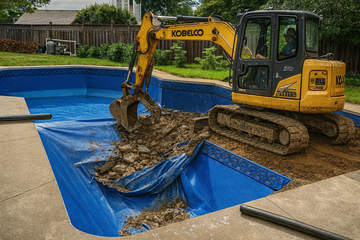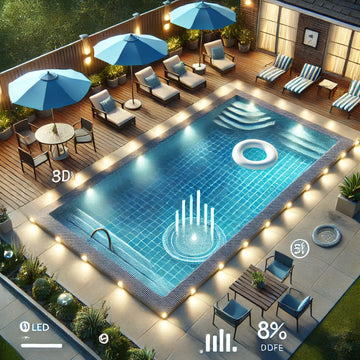POOL WINTERIZING TIPS TO PREVENT YOUR POOL FROM FREEZING
After investing in a pool, it is crucial to maintain your pool all year-round. And as winter approaches, pool owners often worry about potential pool freezing damage and the resulting expensive repairs.
From cracked equipment to burst pipes, freeze damage can be extensive and costly. And it doesn’t take long for pool equipment to freeze in sub-zero temperatures.
So to prevent freeze damage and protect your pool all winter long, follow these tips.
PREVENTING FREEZE DAMAGE
Once the temperature drops below zero, pool water will freeze if precautions aren’t taken, such as pool winterizing or closing and using pool winter covers.
But if you plan to keep your pool open during the winter, then you’ll need to keep the water moving and keep it warm with a pool heater and the following tips to prevent freeze damage:
MAINTAIN PROPER WATER LEVEL
It’s especially important to keep an eye on your pool’s water level in winter. So make sure the water is precisely at mid-skimmer level. This level will keep the water flowing at a constant pace throughout your pool’s system, maintaining a consistent water temperature.
Otherwise, if the water level is too high or too low, there will be circulation issues and damage to the equipment.
INVEST IN AUTOMATIC FREEZE PROTECTION
An automatic freeze protector is a device that detects when the temperature drops close to freezing and runs the pool pump when this happens. It will keep the pump on to circulate water until the outside temperature warms up to a safe temperature above freezing.
PROTECT THE POOL SKIMMER
Since the pool skimmer is made out of thin PVC, it is at risk of cracking if ice forms in the frigid winter months. To protect your skimmer from cracking if the pool freezes, use a Gizzmo, Skimmer Guard, or skimmer bottle to absorb pressure from expanding ice if you don’t plan to keep your pool open and heated.
To make a skimmer bottle, fill 1/3 of an empty plastic water bottle with pool antifreeze, screw on the cap, and drop the bottle in the skimmer.
OPEN ALL VALVES
Double-check that all the valves are open on your pump and filter. And keep all the valves open to ensure the water stays warm and circulating throughout the winter.
OPERATE POOL PUMPS
Keep your pumps running 24/7 in below-freezing temperatures to keep the water circulating, maintain a constant water temperature, and prevent it from freezing. If the water moves at a reasonable velocity through the pool piping and equipment, it won’t freeze.
A variable-speed pump can be used on the low setting to save energy. And when you need emergency freeze protection, you can adjust it to a higher speed.
Also, the best way to avoid having a frozen pool pump is by running it as long as needed to keep the water warm. If the pump freezes, remove the drain plug to relieve pressure from the system.
USE POOL COVERS
Locking a cover on your pool when not in use during the winter will help protect the water from freezing, especially if you use a solar cover. These covers help trap in the heat, so the water stays warm, and the pool remains safe from freeze damage.
INSTALL FREEZE PROTECTION EQUIPMENT
Freeze protection equipment uses a sensor to detect the outside air temperature and automatically turns on your pool pump and heater when the temperature drops to near freezing.
Some types of freeze protection will also open closed valves and turn on other pumps, such as booster and waterfall pumps.
By heating the water and running the pump, the warm water circulates through the pool equipment and pipes and prevents freezing.
WHAT HAPPENS IF THE POOL IS ALREADY FROZEN?
If your pool has already frozen, follow these steps to minimize freeze damage:
- Step 1: Shut off the pump.
- Step 2: Turn off the power to your pool equipment at the circuit breaker.
- Step 3: Use heavy wool blankets or a canvas tarp to form a tent over any pool equipment that is above ground.
- Step 4: Place a small, portable electric heater inside the tent, turn it on low, and allow for cross ventilation. Another option is to use a hairdryer. But be careful to avoid contact with water when using a heater or hairdryer since it can cause electrocution.
- Step 5: Remove the pump lid and pour in some warm water to help melt any ice.
- Step 6: Keep an eye on the equipment as it thaws.
- Step 7: Once the equipment thaws, inspect the pipes and connections for cracks before turning on the pump. If you find any damage to the pipes, valves, pump body, or filter body, drain the equipment well and contact your local pool experts to repair the damaged equipment.
The best way to protect your pool system from freeze damage in winter is by properly winterizing your pool before the freezing temperatures arrive.
But if you don’t want to winterize your pool and close it for the winter, take every precaution to keep the water moving and warm, especially when the temperature drops below freezing.
It doesn’t take long for pipes, pumps, filters, and heaters to experience extensive freeze damage when temperatures reach below zero. So protect your pool this winter and keep it working better for longer with protection from freezing temperatures.



